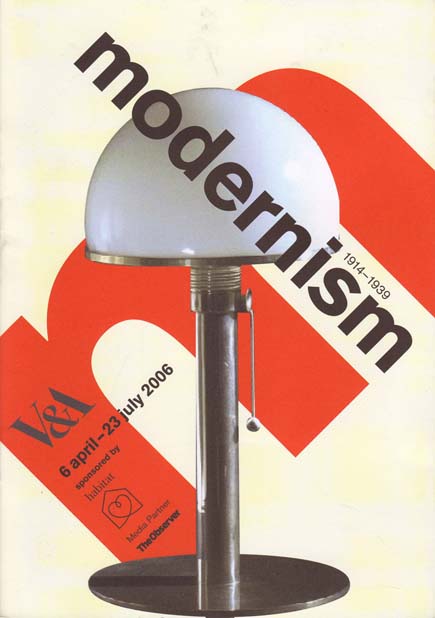
The Victoria & Albert Museum in
London is holding an exhibition of Modernism until July 2006.
It's in quite a small space and liable to get really crowded at peak
times, but is well worth seeing. If you can't get along, or live in
a different country, do have a quick peek at their website
which even has a 'build your own modernist poster' facility with the
best efforts showcased on the site!
Modernism took many forms from Cubo-Futurism to
Bauhaus, but has two identifying characteristics
1. Things will
be better in the future
2. Technology will deliver us to this
utopian future
It arose out of consideration of the pointless waste
of human life that was the First World War and the alternative
posited by the Russian revolution. There was a very
compelling rationale for making things better - the alternative was
truly too horrible to contemplate returning to. This striving for a utopian future is entirely
understandable, albeit naive and starry-eyed with the benefit of
hindsight. With memories of the charnelhouse of war still
fresh, such blind faith in the irreversible evolution of
mankind and protective power of technology is entirely
understandable in a period of rapid technological innovation and
widespread diffusion of what had previously been luxuries thanks to
new methods of mass production. The future was going to be
great and it was just around the corner. There was an
avant-garde who were prepared to shout about it. Moreover such
optimism wasn't restricted to artists and dreamers. Industrial
design became part of the new aesthetic. Better housing for the
people; better furniture and fittings to put in them as well as
uplifting art on the walls. The V&A analyse it under the
following headings:
Searching for utopia
The
very core of the modernist idea is that old ways had to be
completely rethought. The Russian revolution provided a model
for an alternative society. The First World War led to a clamoring
for a better society, which in turn ascribed more importance to
design and art. Cubism and Expressionism had emerged
tentatively before the war, but now the process was taken off the
painter's canvas and set out in brick and metal by architects and
engineers.
The rise of the machine
Unlike
the dystopian vision of machinery set out in Terminator and
Matrix movie franchises, modernists saw mechanisation as
being a desirable development. Mass production techniques advocated
by FW 'Speedy' Taylor and Henry Ford were transforming ordinary
domestic lives for the better - from the spread of electric light to
later waves of cars, washing machines and refrigerators. Machines,
these transforming agents were seen as items of unadorned beauty and
purity of purpose. Form follows function, as the Bauhaus
insisted.
Performing modernism
Obviously,
it wasn't going to be long before the mimes got into the act.
Seriously though, there was a cross-pollination between the
performing arts. Artists such as Ivan Bilibin,
Georges
Braque and Pablo Picasso worked as set designers for
Diaghilev's Ballet Russes. Theatre drew heavily on
the emerging industrial arts and sciences and gave them flair in
return. Admittedly, there was a certain amount of dressing up
in robot costumes.
Building utopia
As the post-war
generation of graduates established themselves in positions as
architects and town planners, they were able to bring to life the
new dynamic whether in the luxury mansions designed by Frank Lloyd
Wright and leCorbusier or the new estates for the masses resulting
from slum clearances in the urban centres. Unlike previous
movements, modernism actually took physical shape. Ready-mixed
concrete had never been so popular.
New aesthetic furniture
People
spend a lot of time around their furniture. Bringing the New Design
to the people, a number of industrial designers such as Marcel Breuer,
Eileen
Gray and Mart
Stam revolutionised the design of furniture. It started
with the chrome and black leather cantilevered creations of the
Bauhaus and ended with the mass-produced hard plastic stackable
chairs you spent primary school sitting on.
Healthy body culture
The 1930s
were when naturism emerged from the, ermm, closet and into the
mainstream. Concern for health was an understandable reaction
to the post-war flu epidemic. Modern buildings should have modern
facilities for modern people. Mens sana in corpore sano.
National modernisms
With its
association with the new and the ideal, modernism was co-opted by
the ascendant right wing totalitarian political movements, taking it
far from its left wing origins. Association with extreme
politics was to sound the death-knell of modernism in its European
home. At the same time, the rise of fascism led to a diaspora
of talent from central Europe, leading to a transmission of ideas to
the UK and more importantly to the United States where it found a
second life idealising the American Dream in the
1950s.
| 
